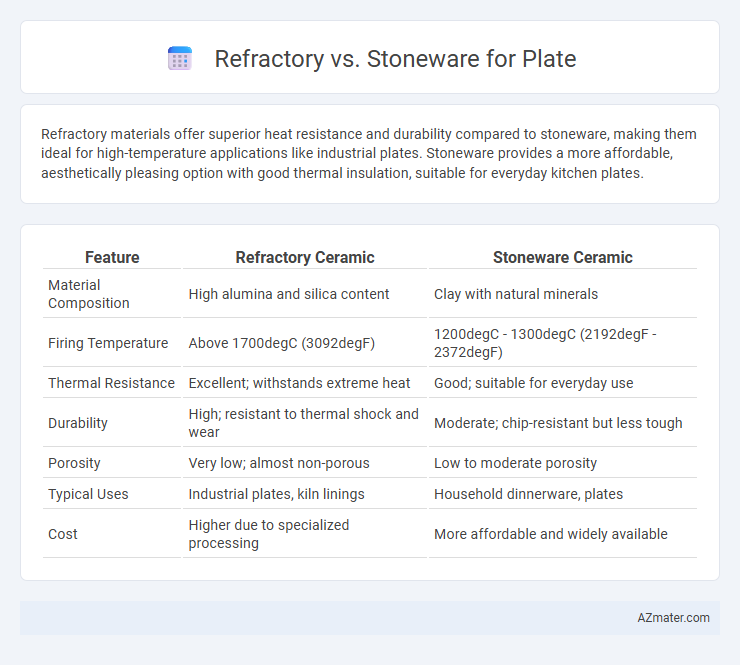Refractory materials offer superior heat resistance and durability compared to stoneware, making them ideal for high-temperature applications like industrial plates. Stoneware provides a more affordable, aesthetically pleasing option with good thermal insulation, suitable for everyday kitchen plates.
Table of Comparison
| Feature | Refractory Ceramic | Stoneware Ceramic |
|---|---|---|
| Material Composition | High alumina and silica content | Clay with natural minerals |
| Firing Temperature | Above 1700degC (3092degF) | 1200degC - 1300degC (2192degF - 2372degF) |
| Thermal Resistance | Excellent; withstands extreme heat | Good; suitable for everyday use |
| Durability | High; resistant to thermal shock and wear | Moderate; chip-resistant but less tough |
| Porosity | Very low; almost non-porous | Low to moderate porosity |
| Typical Uses | Industrial plates, kiln linings | Household dinnerware, plates |
| Cost | Higher due to specialized processing | More affordable and widely available |
Introduction to Refractory and Stoneware
Refractory materials are specifically designed to withstand high temperatures and thermal shock, making them ideal for industrial applications involving heat resistance and durability. Stoneware, a type of ceramic, is fired at high temperatures to achieve strength, density, and non-porous qualities suitable for everyday use, including plates and dinnerware. Understanding the fundamental properties of refractory and stoneware helps in choosing the right material based on thermal resistance and mechanical performance needed for specific plate applications.
Defining Refractory Materials
Refractory materials are specially designed to withstand high temperatures and thermal shock, making them ideal for applications requiring durability in extreme heat, such as refractory plates used in industrial ovens and kilns. Stoneware, a dense and non-porous ceramic fired at high temperatures, offers strength and resistance but does not possess the same level of heat endurance and thermal stability as refractory materials. The key distinction lies in refractory materials' superior capability to maintain structural integrity under continuous exposure to intense heat, whereas stoneware is more suited for everyday dishware and moderate temperature conditions.
Understanding Stoneware Properties
Stoneware plates are fired at high temperatures between 1,200degC and 1,300degC, resulting in a dense, non-porous, and durable surface that resists chipping and scratching. Unlike refractory ceramics designed for extreme heat resistance in industrial applications, stoneware offers excellent thermal shock resistance, making it ideal for everyday kitchen use and oven-to-table service. The vitreous nature of stoneware enhances its moisture resistance and strength, providing a practical balance between toughness and aesthetic appeal for dinnerware.
Heat Resistance: Refractory vs Stoneware
Refractory materials exhibit superior heat resistance compared to stoneware, maintaining structural integrity under extreme temperatures exceeding 1500degC. Stoneware plates typically withstand temperatures up to 1200degC but may risk cracking or warping under sudden thermal shock. The enhanced thermal durability of refractory plates makes them ideal for applications involving direct exposure to high heat sources such as kilns and industrial ovens.
Durability and Longevity Comparison
Refractory materials and stoneware differ significantly in durability and longevity when used for plates. Refractory plates, designed to withstand high heat and thermal shock, exhibit superior resistance to cracking and chipping compared to stoneware. Stoneware plates offer good durability for everyday use but may wear down faster under extreme temperature variations or heavy impact.
Aesthetic Differences in Plates
Refractory plates typically have a denser, smoother surface with minimal glaze variations, resulting in a more uniform and polished aesthetic suitable for modern table settings. Stoneware plates showcase natural textures and earthy glazes that enhance their artisanal appeal, often featuring unique imperfections that add character. The choice between refractory and stoneware plates significantly influences the visual warmth and tactile experience of a dining setup.
Food Safety and Toxicity Considerations
Refractory plates, made from highly durable ceramic materials, often withstand higher temperatures but may contain glazes with potential heavy metals, posing food safety concerns if improperly fired. Stoneware plates are vitrified and typically fired at lower temperatures, reducing the risk of leaching harmful substances and ensuring safer contact with food. Choosing certified lead-free and cadmium-free glazes is crucial in both refractory and stoneware to minimize toxicity and ensure safe dining experiences.
Maintenance and Cleaning Requirements
Refractory plates, made from high-temperature resistant materials like castable refractory, typically require gentle cleaning with non-abrasive tools to avoid surface damage, as harsh scrubbing can degrade their protective lining. Stoneware plates, composed of dense ceramic fired at high temperatures, are more resistant to staining and chipping, making them easier to clean with standard dishwashing methods and less prone to retaining odors or residues. Regular maintenance for refractory involves avoiding sudden temperature shocks to prevent cracking, while stoneware benefits from periodic seasoning or sealing to maintain its glaze and overall durability.
Cost and Accessibility Factors
Refractory plates tend to be more expensive due to their heat-resistant materials and specialized production, making them less accessible for everyday use compared to stoneware plates. Stoneware offers a more affordable option with widespread availability in retail outlets and online stores, appealing to budget-conscious consumers. Cost-effectiveness and easy accessibility make stoneware the preferred choice for most households and casual dining settings.
Choosing the Right Material for Your Plates
Choosing the right material for plates depends on durability and heat resistance, with refractory ceramics excelling in high-temperature environments due to their thermal shock resistance and strength. Stoneware offers a robust, dense structure that is chip-resistant and ideal for everyday use, combining aesthetic appeal with functional durability. Prioritize refractory plates for industrial or high-heat applications, while stoneware suits home kitchens emphasizing resilience and style.

Infographic: Refractory vs Stoneware for Plate
 azmater.com
azmater.com